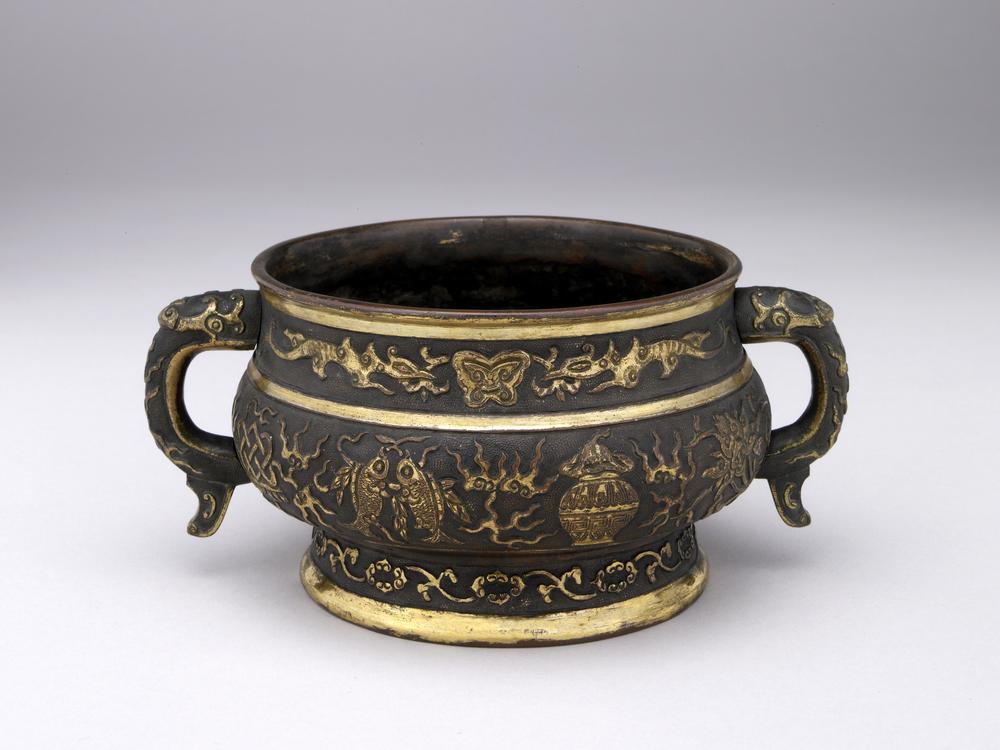Period:Unknown Production date:19thC
Materials:paper
Technique:printed
Dimensions:Height: 39.50 centimetres Width: 51 centimetres
Description:
Album with 24 watercolour prints illustrating ‘ceramic processes’: painting the unglazed ware (no. 5), applying the glaze (no. 6), transport from the factory (no.11), packing in cases for export (no. 12). Ink and colour on paper.
IMG
![图片[1]-album; painting BM-1946-0713-0.1.1-24-China Archive](https://chinaarchive.net/Unknown/Paintings/mid_00303502_001.jpg)
![图片[2]-album; painting BM-1946-0713-0.1.1-24-China Archive](https://chinaarchive.net/Unknown/Paintings/mid_00303503_001.jpg)
![图片[3]-album; painting BM-1946-0713-0.1.1-24-China Archive](https://chinaarchive.net/Unknown/Paintings/mid_00303504_001.jpg)
![图片[4]-album; painting BM-1946-0713-0.1.1-24-China Archive](https://chinaarchive.net/Unknown/Paintings/mid_00303505_001.jpg)
![图片[5]-album; painting BM-1946-0713-0.1.1-24-China Archive](https://chinaarchive.net/Unknown/Paintings/mid_00144694_001.jpg)
![图片[6]-album; painting BM-1946-0713-0.1.1-24-China Archive](https://chinaarchive.net/Unknown/Paintings/mid_00144706_001.jpg)
![图片[7]-album; painting BM-1946-0713-0.1.1-24-China Archive](https://chinaarchive.net/Unknown/Paintings/mid_00144717_001.jpg)
![图片[8]-album; painting BM-1946-0713-0.1.1-24-China Archive](https://chinaarchive.net/Unknown/Paintings/mid_00144721_001.jpg)
![图片[9]-album; painting BM-1946-0713-0.1.1-24-China Archive](https://chinaarchive.net/Unknown/Paintings/mid_00144727_001.jpg)
![图片[10]-album; painting BM-1946-0713-0.1.1-24-China Archive](https://chinaarchive.net/Unknown/Paintings/mid_00144732_001.jpg)
![图片[11]-album; painting BM-1946-0713-0.1.1-24-China Archive](https://chinaarchive.net/Unknown/Paintings/mid_00144735_001.jpg)
![图片[12]-album; painting BM-1946-0713-0.1.1-24-China Archive](https://chinaarchive.net/Unknown/Paintings/mid_00144737_001.jpg)
![图片[13]-album; painting BM-1946-0713-0.1.1-24-China Archive](https://chinaarchive.net/Unknown/Paintings/mid_00144739_001.jpg)
![图片[14]-album; painting BM-1946-0713-0.1.1-24-China Archive](https://chinaarchive.net/Unknown/Paintings/mid_00144748_001.jpg)
![图片[15]-album; painting BM-1946-0713-0.1.1-24-China Archive](https://chinaarchive.net/Unknown/Paintings/mid_00144751_001.jpg)
![图片[16]-album; painting BM-1946-0713-0.1.1-24-China Archive](https://chinaarchive.net/Unknown/Paintings/mid_00144774_001.jpg)
![图片[17]-album; painting BM-1946-0713-0.1.1-24-China Archive](https://chinaarchive.net/Unknown/Paintings/mid_00144878_001.jpg)
![图片[18]-album; painting BM-1946-0713-0.1.1-24-China Archive](https://chinaarchive.net/Unknown/Paintings/mid_00144879_001.jpg)
![图片[19]-album; painting BM-1946-0713-0.1.1-24-China Archive](https://chinaarchive.net/Unknown/Paintings/mid_00144881_001.jpg)
![图片[20]-album; painting BM-1946-0713-0.1.1-24-China Archive](https://chinaarchive.net/Unknown/Paintings/mid_00144883_001.jpg)
![图片[21]-album; painting BM-1946-0713-0.1.1-24-China Archive](https://chinaarchive.net/Unknown/Paintings/mid_00144884_001.jpg)
![图片[22]-album; painting BM-1946-0713-0.1.1-24-China Archive](https://chinaarchive.net/Unknown/Paintings/mid_00144887_001.jpg)
![图片[23]-album; painting BM-1946-0713-0.1.1-24-China Archive](https://chinaarchive.net/Unknown/Paintings/mid_00144889_001.jpg)
![图片[24]-album; painting BM-1946-0713-0.1.1-24-China Archive](https://chinaarchive.net/Unknown/Paintings/mid_00144891_001.jpg)
![图片[25]-album; painting BM-1946-0713-0.1.1-24-China Archive](https://chinaarchive.net/Unknown/Paintings/mid_00144893_001.jpg)
![图片[26]-album; painting BM-1946-0713-0.1.1-24-China Archive](https://chinaarchive.net/Unknown/Paintings/mid_00144894_001.jpg)
![图片[27]-album; painting BM-1946-0713-0.1.1-24-China Archive](https://chinaarchive.net/Unknown/Paintings/mid_00144895_001.jpg)
![图片[28]-album; painting BM-1946-0713-0.1.1-24-China Archive](https://chinaarchive.net/Unknown/Paintings/mid_00144896_001.jpg)
![图片[29]-album; painting BM-1946-0713-0.1.1-24-China Archive](https://chinaarchive.net/Unknown/Paintings/mid_00517375_001.jpg)
![图片[30]-album; painting BM-1946-0713-0.1.1-24-China Archive](https://chinaarchive.net/Unknown/Paintings/mid_00518096_001.jpg)
![图片[31]-album; painting BM-1946-0713-0.1.1-24-China Archive](https://chinaarchive.net/Unknown/Paintings/mid_00518101_001.jpg)
![图片[32]-album; painting BM-1946-0713-0.1.1-24-China Archive](https://chinaarchive.net/Unknown/Paintings/mid_00518105_001.jpg)
![图片[33]-album; painting BM-1946-0713-0.1.1-24-China Archive](https://chinaarchive.net/Unknown/Paintings/mid_00518110_001.jpg)
Comments:Rawson 1992:The excellence of Chinese ceramics owes little to the inspiration of individual potters. It is rather the result of an efficient organization which existed in all manufacturing industries, but especially in the ceramic industry, from earliest times. Division of labour in ceramic workshops made possible the production in the late third century BC of the famous pottery army of China’s first emperor, comprising more than seven thousand life-size figures of warriors and horses. During the Ming dynasty, kilns at a single centre in south China – Jingdezhen – produced sufficient porcelain to supply the whole country and much of the rest of the world as well, using related methods of mass-production.The different tasks, such as preparing the material, forming and decorating the pieces, were subdivided among a number of different craftsmen with many workers involved at each stage, as shown in this series of the processes of porcelain-making. A single item might pass through the hands of as many as seventy men, as described by the Jesuit missionary Pierre d’ Entrecolles in two letters, dated 1712 and 1722:. From R. Tichane, Ching-Te-Chen: ‘Views of a Porcelain City’, New York, 1983, pp. 71-3.The first series such as this was that painted for the Emperor Qianlong (r. 1736-1795) and annotated by his supervisor of porcelain production, Tang Ying. Many similar series were produced in the 19th century in the southern port of Canton, and sold to foreigners.
Materials:paper
Technique:printed
Dimensions:Height: 39.50 centimetres Width: 51 centimetres
Description:
Album with 24 watercolour prints illustrating ‘ceramic processes’: painting the unglazed ware (no. 5), applying the glaze (no. 6), transport from the factory (no.11), packing in cases for export (no. 12). Ink and colour on paper.
IMG
![图片[1]-album; painting BM-1946-0713-0.1.1-24-China Archive](https://chinaarchive.net/Unknown/Paintings/mid_00303502_001.jpg)
![图片[2]-album; painting BM-1946-0713-0.1.1-24-China Archive](https://chinaarchive.net/Unknown/Paintings/mid_00303503_001.jpg)
![图片[3]-album; painting BM-1946-0713-0.1.1-24-China Archive](https://chinaarchive.net/Unknown/Paintings/mid_00303504_001.jpg)
![图片[4]-album; painting BM-1946-0713-0.1.1-24-China Archive](https://chinaarchive.net/Unknown/Paintings/mid_00303505_001.jpg)
![图片[5]-album; painting BM-1946-0713-0.1.1-24-China Archive](https://chinaarchive.net/Unknown/Paintings/mid_00144694_001.jpg)
![图片[6]-album; painting BM-1946-0713-0.1.1-24-China Archive](https://chinaarchive.net/Unknown/Paintings/mid_00144706_001.jpg)
![图片[7]-album; painting BM-1946-0713-0.1.1-24-China Archive](https://chinaarchive.net/Unknown/Paintings/mid_00144717_001.jpg)
![图片[8]-album; painting BM-1946-0713-0.1.1-24-China Archive](https://chinaarchive.net/Unknown/Paintings/mid_00144721_001.jpg)
![图片[9]-album; painting BM-1946-0713-0.1.1-24-China Archive](https://chinaarchive.net/Unknown/Paintings/mid_00144727_001.jpg)
![图片[10]-album; painting BM-1946-0713-0.1.1-24-China Archive](https://chinaarchive.net/Unknown/Paintings/mid_00144732_001.jpg)
![图片[11]-album; painting BM-1946-0713-0.1.1-24-China Archive](https://chinaarchive.net/Unknown/Paintings/mid_00144735_001.jpg)
![图片[12]-album; painting BM-1946-0713-0.1.1-24-China Archive](https://chinaarchive.net/Unknown/Paintings/mid_00144737_001.jpg)
![图片[13]-album; painting BM-1946-0713-0.1.1-24-China Archive](https://chinaarchive.net/Unknown/Paintings/mid_00144739_001.jpg)
![图片[14]-album; painting BM-1946-0713-0.1.1-24-China Archive](https://chinaarchive.net/Unknown/Paintings/mid_00144748_001.jpg)
![图片[15]-album; painting BM-1946-0713-0.1.1-24-China Archive](https://chinaarchive.net/Unknown/Paintings/mid_00144751_001.jpg)
![图片[16]-album; painting BM-1946-0713-0.1.1-24-China Archive](https://chinaarchive.net/Unknown/Paintings/mid_00144774_001.jpg)
![图片[17]-album; painting BM-1946-0713-0.1.1-24-China Archive](https://chinaarchive.net/Unknown/Paintings/mid_00144878_001.jpg)
![图片[18]-album; painting BM-1946-0713-0.1.1-24-China Archive](https://chinaarchive.net/Unknown/Paintings/mid_00144879_001.jpg)
![图片[19]-album; painting BM-1946-0713-0.1.1-24-China Archive](https://chinaarchive.net/Unknown/Paintings/mid_00144881_001.jpg)
![图片[20]-album; painting BM-1946-0713-0.1.1-24-China Archive](https://chinaarchive.net/Unknown/Paintings/mid_00144883_001.jpg)
![图片[21]-album; painting BM-1946-0713-0.1.1-24-China Archive](https://chinaarchive.net/Unknown/Paintings/mid_00144884_001.jpg)
![图片[22]-album; painting BM-1946-0713-0.1.1-24-China Archive](https://chinaarchive.net/Unknown/Paintings/mid_00144887_001.jpg)
![图片[23]-album; painting BM-1946-0713-0.1.1-24-China Archive](https://chinaarchive.net/Unknown/Paintings/mid_00144889_001.jpg)
![图片[24]-album; painting BM-1946-0713-0.1.1-24-China Archive](https://chinaarchive.net/Unknown/Paintings/mid_00144891_001.jpg)
![图片[25]-album; painting BM-1946-0713-0.1.1-24-China Archive](https://chinaarchive.net/Unknown/Paintings/mid_00144893_001.jpg)
![图片[26]-album; painting BM-1946-0713-0.1.1-24-China Archive](https://chinaarchive.net/Unknown/Paintings/mid_00144894_001.jpg)
![图片[27]-album; painting BM-1946-0713-0.1.1-24-China Archive](https://chinaarchive.net/Unknown/Paintings/mid_00144895_001.jpg)
![图片[28]-album; painting BM-1946-0713-0.1.1-24-China Archive](https://chinaarchive.net/Unknown/Paintings/mid_00144896_001.jpg)
![图片[29]-album; painting BM-1946-0713-0.1.1-24-China Archive](https://chinaarchive.net/Unknown/Paintings/mid_00517375_001.jpg)
![图片[30]-album; painting BM-1946-0713-0.1.1-24-China Archive](https://chinaarchive.net/Unknown/Paintings/mid_00518096_001.jpg)
![图片[31]-album; painting BM-1946-0713-0.1.1-24-China Archive](https://chinaarchive.net/Unknown/Paintings/mid_00518101_001.jpg)
![图片[32]-album; painting BM-1946-0713-0.1.1-24-China Archive](https://chinaarchive.net/Unknown/Paintings/mid_00518105_001.jpg)
![图片[33]-album; painting BM-1946-0713-0.1.1-24-China Archive](https://chinaarchive.net/Unknown/Paintings/mid_00518110_001.jpg)
Comments:Rawson 1992:The excellence of Chinese ceramics owes little to the inspiration of individual potters. It is rather the result of an efficient organization which existed in all manufacturing industries, but especially in the ceramic industry, from earliest times. Division of labour in ceramic workshops made possible the production in the late third century BC of the famous pottery army of China’s first emperor, comprising more than seven thousand life-size figures of warriors and horses. During the Ming dynasty, kilns at a single centre in south China – Jingdezhen – produced sufficient porcelain to supply the whole country and much of the rest of the world as well, using related methods of mass-production.The different tasks, such as preparing the material, forming and decorating the pieces, were subdivided among a number of different craftsmen with many workers involved at each stage, as shown in this series of the processes of porcelain-making. A single item might pass through the hands of as many as seventy men, as described by the Jesuit missionary Pierre d’ Entrecolles in two letters, dated 1712 and 1722:. From R. Tichane, Ching-Te-Chen: ‘Views of a Porcelain City’, New York, 1983, pp. 71-3.The first series such as this was that painted for the Emperor Qianlong (r. 1736-1795) and annotated by his supervisor of porcelain production, Tang Ying. Many similar series were produced in the 19th century in the southern port of Canton, and sold to foreigners.
© Copyright
The copyright of the article belongs to the author, please keep the original link for reprinting.
THE END
![[Qing Dynasty] British female painter—Elizabeth Keith, using woodblock prints to record China from the late Qing Dynasty to the early Republic of China—1915-China Archive](https://chinaarchive.net/wp-content/uploads/2022/11/image-191x300.png)




